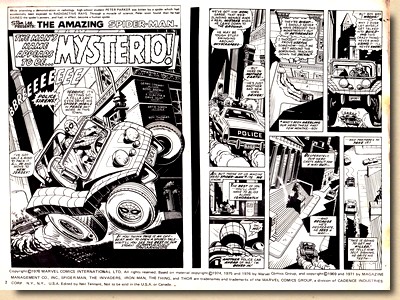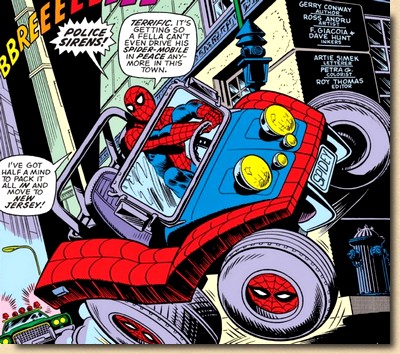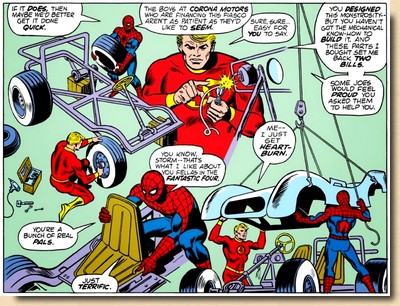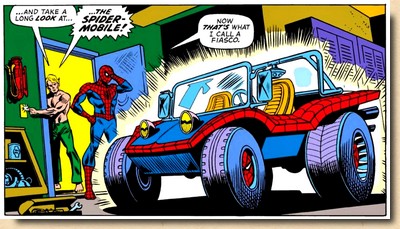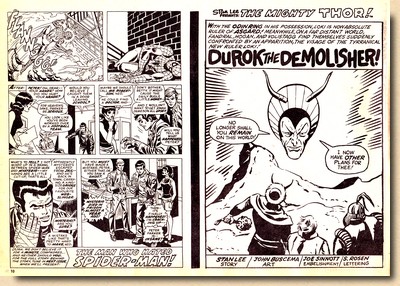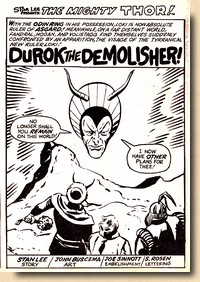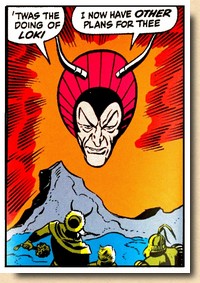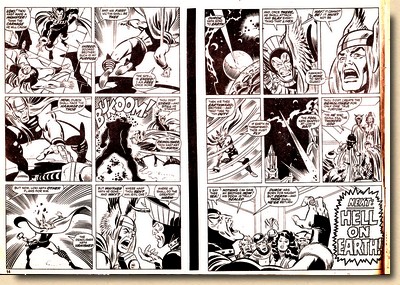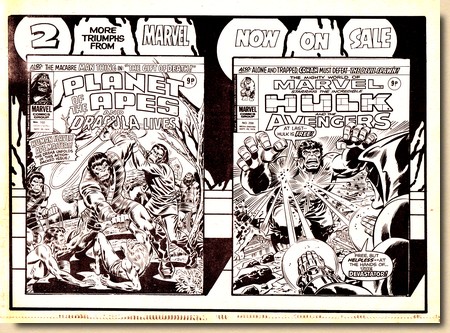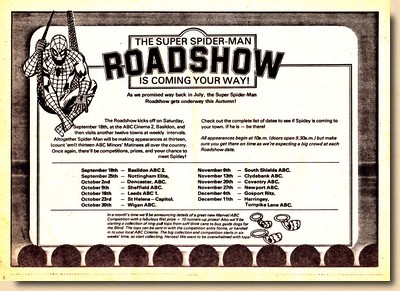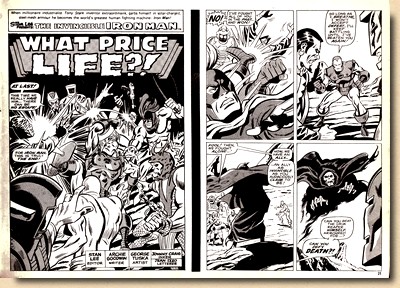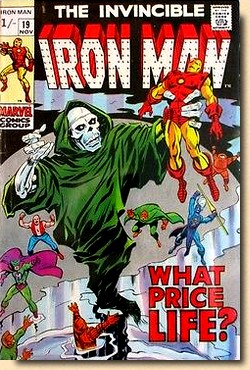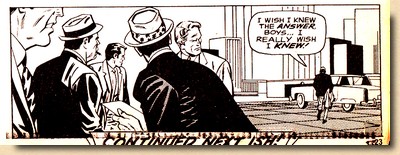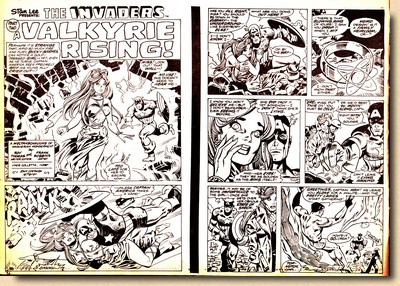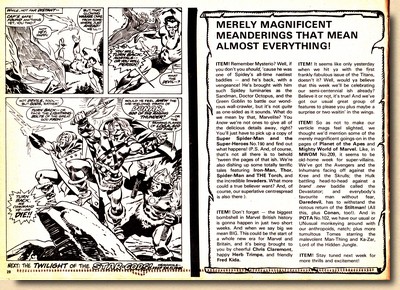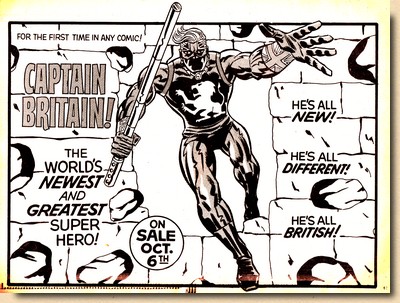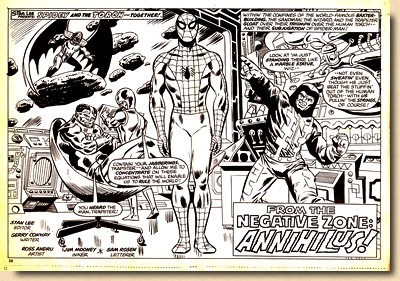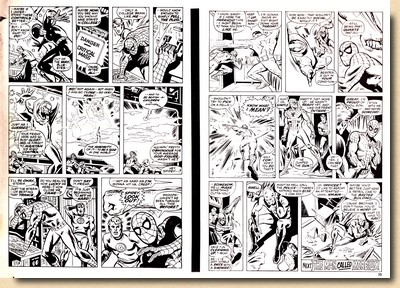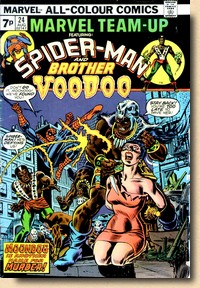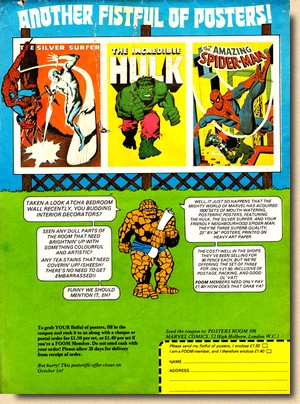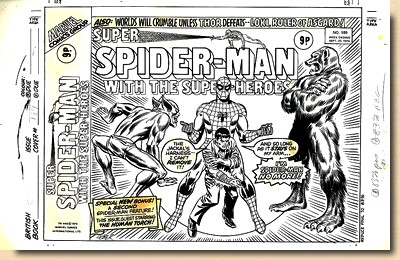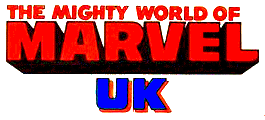 |
|||
| Launched in September 1972,
Marvel Comics' UK imprint (commonly known and refered to
as Marvel UK) enjoyed immediate success, and a
steadily growing number of titles reprinted US material
following the standard 1970s UK comic book market format
of weekly publication and black and white printing.
Following up on the first (and flagship) title Mighty World of Marvel, the most successful and best loved
superhero from the House of Ideas, the Amazing
Spider-Man, was given his own weekly title in February 1973: Spider-Man
Comics Weekly. It would turn out to be one of the longest running UK Marvel comic books (clocking up 666 issues over a 12 year publication run up until 1985) - a fact somewhat obscured by no less than 10 title changes along the way. The first of these occured in February 1976 when Spider-Man Comics Weekly became Super Spider-Man with the Super-Heroes as of issue #158, and essentially was the result of merging the successful Spider-Man Comics Weekly with the somewhat less successful weekly Super-Heroes, which had been launched in March 1975. With the British economy sliding into deep recession in 1976, both such mergers and the resulting composite titles almost became a trademark survival strategy for Marvel UK's weeklies as they braved the harsh market conditions of the mid-1970s. Almost adding insult to injury, Marvel UK also had to fight for readers in competition with the "real deal": copies of US Marvel comics imported to the UK and sold as "Marvel All-Colour Comics" (which would eventually be known as "pence price variants"). One way of pushing and promoting black and white reprints over original colour material at the newsagent was to be eye-catchingly flashy, and the full colour covers of most Marvel UK weeklies did a splendid job in that respect. Another way was, quite simply, to be "different", and it is generally assumed that this was the reasoning behind Marvel UK's decision in late October 1975 to publish a new weekly title (the by then seventh in total) called The Titans in a 8.5" x 11" (21,6 cm x 28 cm) landscape format. Strikingly different in appearance, this highly unusual format made it possible to reprint two original pages side by side on one extra-wide page. While this made the individual panels of a story appear rather small, it gave readers an amazing amount of reprint material per issue for their money - which made it all the harder to decide whether this format was a cumbersome nuisance or a fanboy blessing. The dilemma grew when Spider-Man Comics Weekly became Super Spider-Man with the Super-Heroes in February 1976 and also switched to the landscape format (which previously had remained an exclusive for The Titans). So let's thumb through the 36 pages (or would that be 72 pages?) of Super Spider-Man with the Super-Heroes #190, which went on sale the week ending September 29th 1976. |
|||
| Ever since the launch of
Marvel UK readers in Britain were used to having several
characters feature in one comic book title. As a
consequence, the individual storylines in one issue could
be as short as five or six pages, but given the weekly
publication schedule this didn't really make the stories
any harder to follow than e.g. with the monthly pause
between two US originals. It did, however, create a
distinct segmentation which wasn't always in true snyc
with the creative team's pacing for the original
material. The landscape format of Super Spider-Man with the Super-Heroes - which effectively doubled the page count the way it was used by Marvel UK - made it far easier to reprint one original US issue. Unlike the "original landscape" Titans, where various characters took turns in being the leading character thus treated, it would always be Spidey who got a full issue reprint in Super Spider-Man with the Super-Heroes. |
|||
| A car chase is the inevitable consequence (and the pop culture quote from writer Gerry Conway that it makes Spider-Man feel "just like Steve McQueen" is possibly just as inevitable), and it all seems to go well until ol' webhead makes a right turn down an alley down by the waterfront where all of a sudden a strange purple fog obscures his field of vision - until the Spidermobile drives straight off the end of a pier and plunges into the river together with its driver - who upon resurfacing can't quite understand what happened and how what he perceived to be an alley turned into a pier... | |||
|
|||
| It all came, with an escape hatch, though, as Conway had Spidey thinking "They're right, I should never have dragged this monstrosity out of retirement. I'd chuck the whole thing and simply forget it, if I hadn't made a deal with those clowns at Corona Motors to build the stupid thing". | |||
| It was just one of those things which, as mentioned before, made it really hard to decide whether this format was a pain to read or, given its massive page count of original material reprinted in one issue, a fantastic deal to have. But then in this case it may just as well have served to pull readers into the next feature of Super Spider-Man with the Super-Heroes #190, as the Mighty Thor (evidently) faces Durok the Demolisher... | |||
| The need for additional
splash pages (i.e. large, often full-page illustrations
which open and introduce a story while at the same time
often containing the credits for the artistic team
involved) was a consequence of Marvel UK's concept of
having several features in one title along with a weekly
publication schedule. This meant that a story originally presented
in one US comic book was published over two or three (and
in some cases even more) weekly instalments. In addition to its original function - to signal the beginning of a story segment - the splash pages in Marvel UK's weeklies also served the need to bring readers up to speed who had missed the previous instalment(s), which ultimately also helped accessibility for new readers. One approach was to take a single panel from an original interior page and blow it up to full page size, again adding title and credit panels - such as the splash page taking readers into the Mighty Thor feature running in Super Spider-Man with the Super-Heroes #190. It is easy to see how the original panel was blown up and reworked to serve all of those purposes: adding a caption box at the top containing a recap of previous events as well as a (Marvel UK specific) title to the story, repositioning the word balloons and partly changing their contents, and finally adding a credit box at the bottom. Given that all of this involved original artwork from the material reprinted (in this case, that specific panel had been reproduced in Super Spider-Man with the Super-Heroes #189), splash pages like this one often felt "right" (something which couln't always be said of splash pages created in Marvel's NYC offices for Marvel UK). |
|||
| So far, readers of Super Spider-Man with the Super-Heroes #190 had been presented with an entire US issue of Amazing Spider-Man and half an original issue of Mighty Thor - and they hadn't even reached the center pages of their comic yet. This illustrates what great value for money the Marvel UK landscape titles were - and also how quickly Marvel UK was burning through original material to reprint, based on this formula. | |||
|
|||
| And in that
sense - and just as importantly - the in-house ads also
helped and served to establish and strengthen the Marvel
house style. Another important part of this distinctly
unique and recognizable concept of communication were the
regular letter pages. Involving readers was a completely
alien concept to most if not all British comic book
publishers, and Marvel UK not only talked to and with its
readers through editorial pages, but actually asked for
and encouraged readers to participate and be a part of it
all - the famous "(secret) club atmosphere"
which Stan Lee kept pushing and which, of course, went
down well with British kids and teenagers who most likely
had also had their fair share of exposure to Enid
Blyton's adventure books, Secret Seven and Famous Five. In the case of Super Spider-Man with the Super-Heroes letters from readers wound up in Spidey's Super Mail, of which there were two full pages in issue #190. |
|||
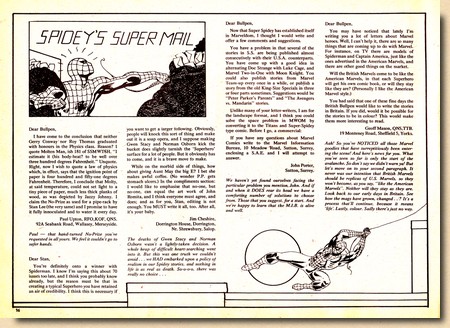 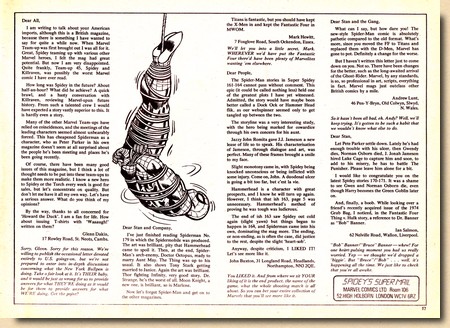 |
|||
| The letters
pages in all of Marvel UK's weeklies always came with
some snappy artwork, but the most interesting aspect from
today's perspective is seeing how individual readers
writing in were travelling at vastly different speeds
through the Marvel Universe. Some were in the know about
"no prizes" and how to get them, such as Paul
Upton from Merseyside (he clinched one here), while
others clearly were less
seasoned fans and blissfully unaware of the fact that
these were all reprint comics and that making any
suggestions as to future plots or changes in the creative
team line-up were, of course, completely futile. And then
there was the fairly regular stream of readers writing in
about the US imports to the UK, the "pence price
variants", and those asking for colour to
replace the black and white printing. Editorial answered them all politely
and in the house style of the club, and everybody seemed
happy and continued to write in - like John Porter from
Sutton. He raised a good point in this issue of Super Spider-Man with the Super-Heroes when he noted that "you have a problem in that several of the stories in S[uper]S[pider-Man] are being published almost consecutively with their USA counterparts". Editorial didn't feel that way (or didn't feel like admitting it), but the problem was obvious to those who understood the American comic book market: if you have eighteen to twenty original pages a month and you reprint those on a weekly basis, you are bound to catch up with the original material, and reprinting entire issues (as in the first year of Spider-Man Weekly and now in Super Spider-Man with the Super-Heroes) only meant that Marvel UK would catch up with and then run out of original material fast. |
|||
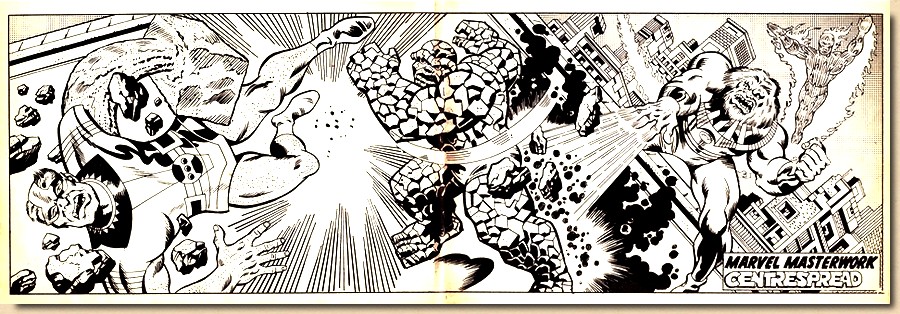 |
|||
| Super Spider-Man with the Super-Heroes had five separate features in every issue in 1976, so it was clear that it could not all be the entirety or a half of original US issues - and in issue #190, it was Iron Man who got the short end of the stick. | |||
|
|||
| For Marvel UK's editorial, this was something of a bothersome instalment, as this story had kicked off in US Iron Man #17 and then moved back and forth between Iron Man #18, Avengers #69, Iron Man #19 and, for its conclusion, Avengers #70. No doubt a measure aimed at boosting sales of Iron Man's title by getting regular Avengers readers to pick up (and hopefully stay with) the title, it certainly required some extra planning for reprint schedules. | |||
| It is the kind of story that rarely disappoints its readers, not the least due to the heavy dose of Marvel Universe it conveys. More of this, however, would have to wait until the next issue of Super Spider-Man with the Super-Heroes. Pushing the pause button in these cases (i.e. somewhere in the page count of an original US issue) was usually fairly easy for Marvel UK editorial as they would simply insert - or squeeze in, as illustrated here - a text box at the bottom of the original panel reading "CONTINUED NEXT ISH!". | |||
| The newest material to be
reprinted in Super Spider-Man with the
Super-Heroes #190, this adventure from the first
issue of the Invaders' ongoing series was only slightly
more than one year old - and a first for readers in great
Britain. For although they would find pence price copies
of The Invaders #3-40 at their newsagent, the
first two issues as well as the final issue (#41) were
not distributed in the UK [1]. The material was representative of Marvel's Bronze Age expansion, but the Invaders actually had their roots in the Golden Age and creator Roy Thomas' love for the characters of that era. Based on the All-Winners Squad from Timely's All Winners Comics #19 (Fall 1946) and #21 (Winter 1947), the line-up was almost identical: Captain America, his sidekick Bucky, the original android Human Torch, the Torch's sidekick Toro, and Namor the Sub-Mariner. |
|||
| Essentially an expanded checklist of all of Marvel UK's titles on sale the same week as Super Spider-Man with the Super-Heroes #190, it tied in well with the Invaders as one bulletpoint item told readers not to forget that "the biggest bombshell in Marvel British history is gonna happen in just two short weeks." | |||
| Publishing Super
Spider-Man with the Super-Heroes as a landscape
format weekly which reprinted an entire issue of Amazing
Spider-Man pushed the accelerator down in a
substantial way with regard to Marvel UK catching up with
the original US material. By the time SSMSH #190
hit the newsagent displays, the inventory of original
material from Amazing Spider-Man had shrunk to a
mere 18 months' worth of US issues; given the publication
schedule at the time, that stock would last a mere four
and a half months in Super Spider-Man with the
Super-Heroes. But as the popularity of Spider-Man
practically demanded a substantial presence every week,
editorial even introduced a second Spidey feature. Marvel UK thus turned to Marvel Team-Up, which had kicked off in the US in March 1972 for similar reasons that it was now being reprinted in Super Spider-Man with the Super-Heroes: A second title would allow Marvel to cash in on the popularity and selling strength of Spider-Man. |
|||
| Nevertheless, the 1970s issues of Marvel Team-Up had their own charm, due in large parts to the seasoned writers, pencillers and inkers who worked on the stories. And now Super Spider-Man with the Super-Heroes was providing UK readers with their first chance to actually get a taste of the very early Marvel Team-Up yarns - although the title as such could be seen at the time at newsagents who carried Marvel US comics exported to and priced for the British market. | |||
|
|||
| It was a comic book which at times felt slightly awkward but ultimately gave readers an incredible amount of stories and number of characters a week for 9 pence in 1976 - virtually double in comparison to what the regular format reprint titles would offer at the same price. Positive and negative opinions regarding the landscape orientation seemed to be fairly evenly split if the letters pages are an indicator to go by. | |||
| The paper used for the
British weekly was generally a superior type of newsprint
in comparison to the quality grade used for US comics at
the time. As a result, the Marvel UK weeklies usually
kept better, but as the scans used here illustrate they
ultimately were just as prone to the common paper degradation processes (most importantly yellowing) if
stored in a warm place and exposed to light. To make
things worse, paper used in the 1970s had a high level of
acidity (as can also be seen from many paperback books
from that same period). And finally, Super Spider-Man with The Super-Heroes also illustrates that Marvel UK wasn't all reprint. Leaving aside Captain Britain, a huge number of splashpages and covers were produced in Marvel's New York offices for the British weeklies. |
|||
|
|||
| The cover of Super Spider-Man with The Super-Heroes #190 essentially uses the cover of Amazing Spider-Man #141, but due to the landscape format the group of villains facing Spidey had to be stretched out horizontally, resulting in some reworking (e.g. the altered leg position of the Jackal or the hands and tentacles of Doc Ock) and changes to the word balloons. In comparison, a German reprint of ASM #141 was able to simply reuse the original cover as such. | |||
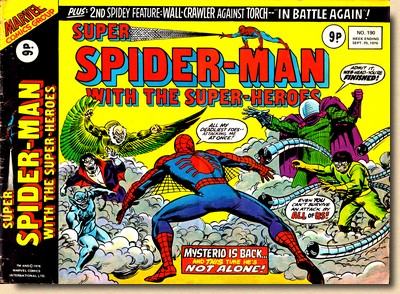 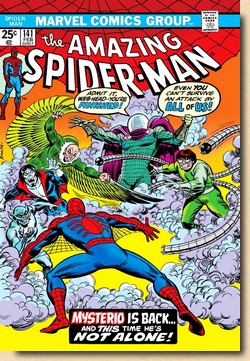 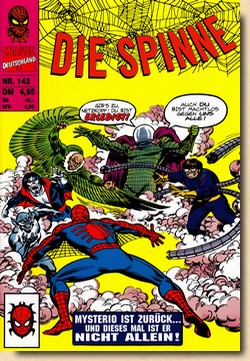 |
|||
| NOTES [1] According to the Comic Book Price Guide for Great Britain [2] According to the Comic Book Price Guide for Great Britain |
|||
Uploaded to the web 6 May 2015 |
|||
|
|||
